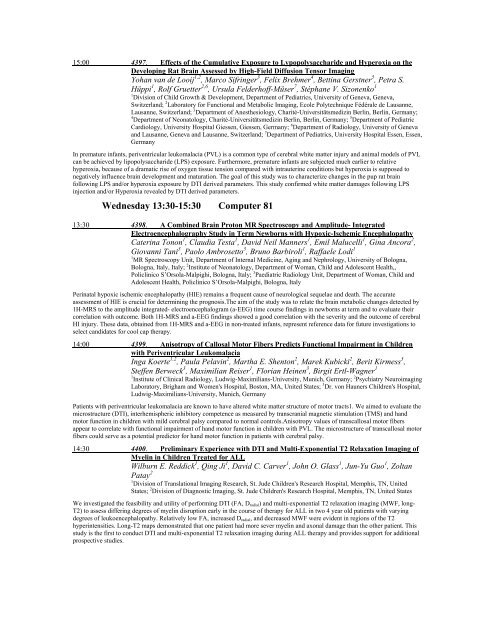Electronic Posters: Neuroimaging - ismrm
Electronic Posters: Neuroimaging - ismrm
Electronic Posters: Neuroimaging - ismrm
Create successful ePaper yourself
Turn your PDF publications into a flip-book with our unique Google optimized e-Paper software.
15:00 4397. Effects of the Cumulative Exposure to Lypopolysaccharide and Hyperoxia on the<br />
Developing Rat Brain Assessed by High-Field Diffusion Tensor Imaging<br />
Yohan van de Looij 1,2 , Marco Sifringer 3 , Felix Brehmer 4 , Bettina Gerstner 5 , Petra S.<br />
Hüppi 1 , Rolf Gruetter 2,6 , Ursula Felderhoff-Müser 7 , Stéphane V. Sizonenko 1<br />
1 Division of Child Growth & Development, Department of Pediatrics, University of Geneva, Geneva,<br />
Switzerland; 2 Laboratory for Functional and Metabolic Imaging, Ecole Polytechnique Fédérale de Lausanne,<br />
Lausanne, Switzerland; 3 Department of Anesthesiology, Charité-Universitätsmedizin Berlin, Berlin, Germany;<br />
4 Department of Neonatology, Charité-Universitätsmedizin Berlin, Berlin, Germany; 5 Department of Pediatric<br />
Cardiology, University Hospital Giessen, Giessen, Germany; 6 Department of Radiology, University of Geneva<br />
and Lausanne, Geneva and Lausanne, Switzerland; 7 Department of Pediatrics, University Hospital Essen, Essen,<br />
Germany<br />
In premature infants, periventricular leukomalacia (PVL) is a common type of cerebral white matter injury and animal models of PVL<br />
can be achieved by lipopolysaccharide (LPS) exposure. Furthermore, premature infants are subjected much earlier to relative<br />
hyperoxia, because of a dramatic rise of oxygen tissue tension compared with intrauterine conditions but hyperoxia is supposed to<br />
negatively influence brain development and maturation. The goal of this study was to characterize changes in the pup rat brain<br />
following LPS and/or hyperoxia exposure by DTI derived parameters. This study confirmed white matter damages following LPS<br />
injection and/or Hyperoxia revealed by DTI derived parameters.<br />
Wednesday 13:30-15:30 Computer 81<br />
13:30 4398. A Combined Brain Proton MR Spectroscopy and Amplitude- Integrated<br />
Electroencephalography Study in Term Newborns with Hypoxic-Ischemic Encephalopathy<br />
Caterina Tonon 1 , Claudia Testa 1 , David Neil Manners 1 , Emil Malucelli 1 , Gina Ancora 2 ,<br />
Giovanni Tani 3 , Paolo Ambrosetto 3 , Bruno Barbiroli 1 , Raffaele Lodi 1<br />
1 MR Spectroscopy Unit, Department of Internal Medicine, Aging and Nephrology, University of Bologna,<br />
Bologna, Italy, Italy; 2 Institute of Neonatology, Department of Woman, Child and Adolescent Health,,<br />
Policlinico S’Orsola-Malpighi, Bologna, Italy; 3 Paediatric Radiology Unit, Department of Woman, Child and<br />
Adolescent Health, Policlinico S’Orsola-Malpighi, Bologna, Italy<br />
Perinatal hypoxic ischemic encephalopathy (HIE) remains a frequent cause of neurological sequelae and death. The accurate<br />
assessment of HIE is crucial for determining the prognosis.The aim of the study was to relate the brain metabolic changes detected by<br />
1H-MRS to the amplitude integrated- electroencephalogram (a-EEG) time course findings in newborns at term and to evaluate their<br />
correlation with outcome. Both 1H-MRS and a-EEG findings showed a good correlation with the severity and the outcome of cerebral<br />
HI injury. These data, obtained from 1H-MRS and a-EEG in non-treated infants, represent reference data for future investigations to<br />
select candidates for cool cap therapy.<br />
14:00 4399. Anisotropy of Callosal Motor Fibers Predicts Functional Impairment in Children<br />
with Periventricular Leukomalacia<br />
Inga Koerte 1,2 , Paula Pelavin 2 , Martha E. Shenton 2 , Marek Kubicki 2 , Berit Kirmess 3 ,<br />
Steffen Berweck 3 , Maximilian Reiser 1 , Florian Heinen 3 , Birgit Ertl-Wagner 1<br />
1 Institute of Clinical Radiology, Ludwig-Maximilians-University, Munich, Germany; 2 Psychiatry <strong>Neuroimaging</strong><br />
Laboratory, Brigham and Women's Hospital, Boston, MA, United States; 3 Dr. von Hauners Children's Hospital,<br />
Ludwig-Maximilians-University, Munich, Germany<br />
Patients with periventricular leukomalacia are known to have altered white matter structure of motor tracts1. We aimed to evaluate the<br />
microstructure (DTI), interhemispheric inhibitory competence as measured by transcranial magnetic stimulation (TMS) and hand<br />
motor function in children with mild cerebral palsy compared to normal controls.Anisotropy values of transcallosal motor fibers<br />
appear to correlate with functional impairment of hand motor function in children with PVL. The microstructure of transcallosal motor<br />
fibers could serve as a potential predictor for hand motor function in patients with cerebral palsy.<br />
14:30 4400. Preliminary Experience with DTI and Multi-Exponential T2 Relaxation Imaging of<br />
Myelin in Children Treated for ALL<br />
Wilburn E. Reddick 1 , Qing Ji 1 , David C. Carver 1 , John O. Glass 1 , Jun-Yu Guo 1 , Zoltan<br />
Patay 2<br />
1 Division of Translational Imaging Research, St. Jude Children's Research Hospital, Memphis, TN, United<br />
States; 2 Division of Diagnostic Imaging, St. Jude Children's Research Hospital, Memphis, TN, United States<br />
We investigated the feasibility and utility of performing DTI (FA, Dradial) and multi-exponential T2 relaxation imaging (MWF, long-<br />
T2) to assess differing degrees of myelin disruption early in the course of therapy for ALL in two 4 year old patients with varying<br />
degrees of leukoencephalopathy. Relatively low FA, increased Dradial, and decreased MWF were evident in regions of the T2<br />
hyperintensities. Long-T2 maps demonstrated that one patient had more sever myelin and axonal damage than the other patient. This<br />
study is the first to conduct DTI and multi-exponential T2 relaxation imaging during ALL therapy and provides support for additional<br />
prospective studies.
















